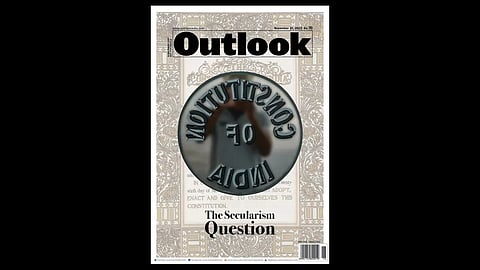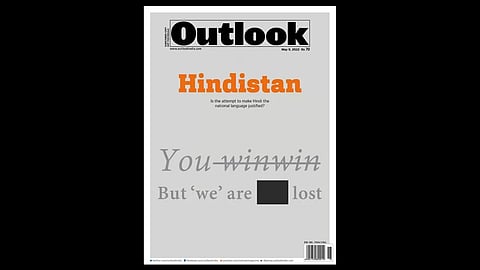The architect of the?Indian constitution, Dr.?B. R. Ambedkar, during his last speech in the constituent assembly on November 25, 1949, said, “On the 26th of January 1950, India would be a democratic country in the sense that India from that day would have a government of the people, by the people and for the people.” ?
How ‘WE, THE PEOPLE OF INDIA’ Have Performed As A Republic?
In the context of the 74th Republic day, we in Outlook, take a small journey to recall how we perceived and interrogated the idea of the Republic throughout the year, bringing back the debates that make ‘Us’.
This promise of a ‘Republic’ that will be run by the people, not by the wills and whims of any monarch, also got resonated in his words when he referred to the famous comment of political scientist John Stuart Mill and uttered that any democracy survives only when the people do not “lay their liberties at the feet of even a great man, or to trust him with power which enables him to subvert their institutions.” ?
Further, the emphasis on ‘WE, THE PEOPLE OF INDIA’ in the very preamble of our Constitution makes us think through what does its ‘People’ mean for a ‘Republic’? What are its features? How do we conceive such an abstract ideal in our everyday life? At a time when we are living amidst the battles of competing ideas, we may look through how we had reached the point where our ancestors claimed a ‘Republic’, discarding the ‘dominion’, a prevalent structure of colonial governance during the early twentieth century. ?
The Pledge to form a Republic?
In the 1920s, both through The Commonwealth of India Bill, 1925 and Nehru Report, 1928 made by Motilal Nehru, Indian nationalists sought a dominion status, similar to that of Australia and Canada, where the head of the constitution would be Queen/King of England and the power to govern will symbolically flow from them. However, a section of the Congress party was not at all satisfied with the idea. In the December 1928 session of Congress in Calcutta, Jawaharlal Nehru, Netaji Subhash Chandra Bose and Satyamurthi opposed the dominion status and advised the committee to adopt a resolution for Purna Swaraj or full independence. ?
Motilal Nehru and Mohandas Gandhi nevertheless were of the opinion that for now they should accept it and warned that if the promise of dominion status is not fulfilled within one year, they would start a movement for full independence. Consequently, on October 31, 1929, the?then Viceroy of India, Lord Irwin announced that India would be granted dominion status. ?
However, his declaration, famously known as Irwin Declaration received huge backlash in England. The House of Lords on November 5, 1929, crushed the demands and on December 23, Irwin informed Gandhi about his inability to grant the promised status. This was the moment when Indian nationalist forces pledged to make an India, that would only be ruled by, “WE”, the people of India and the power will not flow from the monarch, even symbolically, rather it will be legitimised through the “People”, the citizens of this country. ?
On December 31, 1929, in the historic Lahore session of Congress when the party adopted the resolution of Purna Swaraj, Jawaharlal Nehru said, “I must frankly confess that I am a socialist and a Republican, and am no believer in kings and princes, or in the order which produces the modern kings of industry, who have greater power over the lives and fortunes of men than even the kings of old, and whose methods are as predatory as those of the old feudal aristocracy.”
The Struggle For Federalism ?
This essence of Republic got reverberated throughout the nationalist movement and besides the supremacy of people, it celebrated and upheld the ideals of Federalism, Constitutionalism, Secularism and Democracy, both as its constituents and derivatives. The ideals of federalism or the separation of power between the Centre and provinces were first discussed in the first Round Table Conference in 1930. When the Government of India Act, 1935 came into shape, provinces were given the ‘provincial list’ of subjects upon which they could legislate. ?
Cabinet Mission Plan of 1946 also proposed a ‘federal union’ where the Centre will have the legislative power only in three areas- defence, external affairs and communication. ?
However, the partition of India certainly became a rallying point for those who believed that federalism will give birth to secessionism. ?
During the constituent assembly debates, one could find this sentiment resonated among several leaders. Brajeshwar Prasad, a leader from Bihar said, “I am opposed to federalism because I fear that with the setting up of semi-sovereign part-states, centrifugal tendencies will break up Indian unity. Provincial autonomy led to the vivisection of the country. Federalism will lead to the establishment of innumerable Pakistans in this sub-continent.” ?
However, Ambedkar was of the opinion that there should be limits on the power of the Centre. Once, he famously said, “We must resist the tendency to make it (Centre) strong. It cannot chew more than it can digest. Its strength must be commensurable to its weight.” ?
Article 1 of the Constitution clearly refers to India as the “Union of States” without explicitly mentioning the word ‘federal’. However, the state list, union list and concurrent list along with Article 246 and Article 243G which distributes the responsibilities, makes federalism an embedded feature of the Constitution.?
Among the scholars, though there have been several discussions regarding the characteristic of Indian federalism, the most popular and debated one is what Rekha Saxena in one of her EPW papers calls “Asymmetrical federalism” which consists of both political and constitutional asymmetry. Saxena rightly points out that the different sections to rule different states (like Mizoram, Nagaland, and earlier Kashmir before the scrapping of Article 370) and different representations on the basis of demographic and geographic locations push these asymmetries- that brings out diversities and boosts the federal structure.?
Our ideals always have high moral value; but how have we performed in these years? Have we fulfilled the dreams of the architects of the Constitution? From the first dismissal of the Communist government of Kerala in 1959 to the reports of the 1983 Sarkaria Commission that show how the Centre had deployed Article 356 more than 90 times to overrule the power of the states, we get a glimpse of our performance. ?
When Outlook Looks Into The Meaning Of The Republic ?
In the context of the 74th Republic day, we in Outlook, take a small journey to recall how we perceived and interrogated the idea of the Republic throughout the year. To make it more comprehensive for our readers, we look through the lenses of Federalism, Secularism and Language domination to realise what does it mean to be the ‘We’ of the Republic? ?
In our issue dated February 28, 2022, we looked at the debates on federalism and tried to understand how the struggle has been shaped in recent days. Professor Tanvir Aeijaz in his piece titled Federalism and the Idea of Regionalism rightly points out, “In federalism, it is important to share the federal powers—precisely for shared-rule and self-rule—but it is all the more important to use those powers for achieving constitutional goals and morality and also for holding out together the beautiful Indian diversity.” ?
Senior journalist Mohd. Faisal shows us how identity politics is playing its roles at a minuscule level, promoting the formation of small organisations in different regions that are gradually getting co-opted by the larger political sharks. G C Shekhar looks back at Dravidian politics and how it has fought the burden of Centre’s pressures. Unpacking federalism in a more transparent manner, Yamini Aiyar notes, “By prising open spaces for negotiation and accommodation of India’s ethnic, regional and linguistic diversity, it is this federal principle that has enabled the modern Indian nation-state to cohere.” ?
Our this journey to understand the debates on federalism was complemented by our efforts to deconstruct secularism in a nuanced manner. Our issue dated November 21, 2022, titled The Secular Question brings in all the moments when our secular credentials had been questioned. We looked broadly at the concept of the Indian form of secularism in contrast to western notions. ?

While S Y Qureshi takes us on a walk through the journey of Indian secularism, Ajay Gudavarthy calls it a ‘colossal failure’. Political scientist Mujibur Rehman interestingly points out the ‘aspiration’ of India to be a secular country. Through these analytical understandings, we keep our question open to the readers- do we have secular credentials? ?
While federalism and secularism are the major two tenets of a democratic republic, without the essence of lingual diversity, it cannot thrive for political and social democracy. Our issue of May 9, 2022, titled Hindistan rightly looks at the multiple complexities that the efforts to impose Hindi on the non-Hindi population may bring in. From Meena Kandasamy, we hear of the struggles of the Tamils to save their ‘pride’ in front of ongoing Hindi onslaughts. Garga Chatterjee tells us the story of Hindi chauvinism that tried to occupy the space of the National Language, even after severe opposition. ?

All of our issues unpack the conditions through which the Republic has been surviving for more than 70 years. To celebrate Republic day, we must listen to those parts of Tagore’s poem, that we don’t sing as National Anthem. The hope embedded in it reads, ?
Raatri Prabhatilo Udilo Rabichhabi, Purbo Udayo Giri Bhaaley?
Gaahey Bihangamo Punyo Samirano, Nabo Jibano Rasho Dhaley?
Tabo Karunaaruno Ragey,Nidrito Bhaarato JageyTabo Chorone Noto Maatha?
Jayo Jayo Jayo Hey, Jayo Rajeshwaro, Bhaarato Bhaagyo Bidhaataa?
Jayo Hey, Jayo Hey, Jayo Hey,Jayo Jayo Jayo, Jayo Hey?
(The night is over, and the sun has risen over the hills of the eastern horizon.?
The birds are singing, and a gentle auspicious breeze is pouring the elixir of new life.?
By the halo of your compassion, India that was asleep is now waking.?
On your feet we lay our heads.?
Victory, victory, victory be to you, the supreme king, the dispenser of the destiny of India!?
Victory to you, victory to you, victory to you...)?